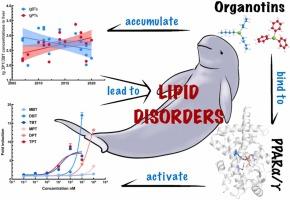Phenyltins May Pose a Higher Health Risk to Indo-Pacific Finless Porpoises Than Butyltins
IF 11.3
1区 环境科学与生态学
Q1 ENGINEERING, ENVIRONMENTAL
引用次数: 0
Abstract
Organotin (OT) compounds are commonly used in antifouling paints, but can cause toxic effects in various marine organisms, including gastropods, amphibians, and teleosts. The effects of these chemicals on marine mammals remain largely unknown. We comprehensively investigated the accumulation patterns and health risks of six OTs in Indo-Pacific finless porpoises (Neophocaena phocaenoides) from the Pearl River Estuary (PRE), China, from 2007 to 2020. Six OTs were detected in all the finless porpoise samples, with tributyltin (TPT) and dibutyltin (DBT) being the dominant chemicals in the liver and muscle, respectively. The mean hepatic concentration of TPT (516.1 ng g-1 wet weight) exceeded the levels reported for cetaceans from other regions. Despite the observed decreasing trends of butyltins (BTs) in recent years, which aligns with the global restriction of OT-based antifouling paints since 2008, phenyltins (PTs) have continued to increase in porpoise tissues, suggesting continued deposition of PTs in the PRE. In vitro, the tissue-relative concentrations of TPT, tributyltin, and DBT-induced lipid disruption by activating the finless porpoise peroxisome proliferator-activated receptor α/γ (npPPARα/γ). In silico simulations further revealed a higher toxic potential of PTs than BTs on npPPARα/γ. Our results underscore the urgency for further monitoring and elimination of PTs in China.

与丁基锡化合物相比,苯基锡化合物可能对印度洋太平洋江豚构成更大的健康风险
有机锡(OT)化合物通常用于防污涂料,但会对各种海洋生物造成毒性作用,包括腹足类动物、两栖动物和硬骨鱼。这些化学物质对海洋哺乳动物的影响在很大程度上仍然未知。摘要对2007 - 2020年珠江口印度-太平洋无鳍江豚(Neophocaena phocaenoides)体内6种OTs的积累规律和健康风险进行了综合研究。在所有江豚样本中均检测到6种OTs,其中肝脏和肌肉中的主要化学物质分别为三丁基锡(TPT)和二丁基锡(DBT)。肝脏中TPT的平均浓度(516.1 ng g-1湿重)超过了其他地区鲸类的报告水平。尽管近年来观察到丁胺素(bt)的减少趋势,这与2008年以来全球对基于ot的防污涂料的限制一致,但苯基丁胺素(PTs)在海豚组织中继续增加,表明PTs在PRE中继续沉积。在体外,TPT、三丁基锡和dbt的组织相对浓度通过激活江豚过氧化物酶体增殖物激活受体α/γ (npPPARα/γ)诱导脂质破坏。计算机模拟进一步揭示了PTs对npPPARα/γ的毒性潜力高于bt。我们的研究结果强调了进一步监测和消除PTs在中国的紧迫性。
本文章由计算机程序翻译,如有差异,请以英文原文为准。
求助全文
约1分钟内获得全文
求助全文
来源期刊

Journal of Hazardous Materials
工程技术-工程:环境
CiteScore
25.40
自引率
5.90%
发文量
3059
审稿时长
58 days
期刊介绍:
The Journal of Hazardous Materials serves as a global platform for promoting cutting-edge research in the field of Environmental Science and Engineering. Our publication features a wide range of articles, including full-length research papers, review articles, and perspectives, with the aim of enhancing our understanding of the dangers and risks associated with various materials concerning public health and the environment. It is important to note that the term "environmental contaminants" refers specifically to substances that pose hazardous effects through contamination, while excluding those that do not have such impacts on the environment or human health. Moreover, we emphasize the distinction between wastes and hazardous materials in order to provide further clarity on the scope of the journal. We have a keen interest in exploring specific compounds and microbial agents that have adverse effects on the environment.
 求助内容:
求助内容: 应助结果提醒方式:
应助结果提醒方式:


